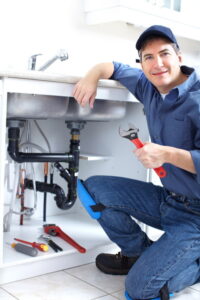 Let’s talk about an important part of your sink, one that you probably didn’t even know the name of although you’ve seen it often. It’s the bent section of the drainpipe right below the drain, the one you can see when you open the below-sink cabinets. This pipe with the peculiar curve is known as a p-trap, and today you’re going to learn why it’s there and how it can develop problems.
Let’s talk about an important part of your sink, one that you probably didn’t even know the name of although you’ve seen it often. It’s the bent section of the drainpipe right below the drain, the one you can see when you open the below-sink cabinets. This pipe with the peculiar curve is known as a p-trap, and today you’re going to learn why it’s there and how it can develop problems.
Why is it called a p-trap?
When you first look at the p-trap, you might wonder why it’s not called a u-trap. However, if you look at the section of pipe detached from the sink and the wall, you’ll see that the pipe is shaped like the letter “p.” As for the trap part, this describes its main function: to trap water. After the water runs down the drain, gravity will trap some of the water in the curved section.
The job of the p-trap
Why trap water in the drainpipe? It’s to serve as a barrier between the sink drain and the rest of the wastewater system of the house. Like all the drains in the home, the sink drain eventually leads to the sewer main and out to the municipal sewer system. Sewer gas naturally rises, and it will flow right back up a drain pipe and out the drain, sending out foul odors. The water in the p-trap prevents this from happening.
The dried p-trap
At this point, you might start to wonder what would happen if the water in the p-trap evaporated. This can happen, and it often does for sinks that don’t see a lot of use, such as in a guest bathroom or a utility room. When the p-trap dries up, sewer odors will start to escape. Fortunately, this is an easy problem to address: simply run water down the drain for about a minute to restore the water in the trap.
The leaking p-trap
Like any pipe, a p-trap can develop leaks from wear, corrosion, and other sources. Most p-traps today are made from PVC plastic, although there are still many made of metal. If you notice water dripping under the sink, the first culprit to check is the p-trap. The good news about these leaks is that plumbers can easily remedy them. If they can’t repair the pipe, it’s a simple operation for a plumber to remove the pipe section and replace it—these pipes have standard sizes.
The clogged p-trap
Is your bathroom or kitchen sink clogged or slow? A blocked p-trap is often the source of the problem. The curved shape that catches water can also trap debris such as hair, soap scum, food particles, or tiny objects dropped down the drain. Hair clogs are especially pernicious in bathroom sinks and shower drains. The solution to clogs isn’t to use chemical drain cleaners, which can easily damage the p-trap material. Plungers and basic drain augers can help, but professional drain cleaning is the best long-term solution.
For all your needs when it comes to sink plumbing in Plattsburgh, NY, trust our team!
Red Rock Mechanical, LLC serves Northwest Vermont and Northeast New York. Call for great professional plumbing solutions.







